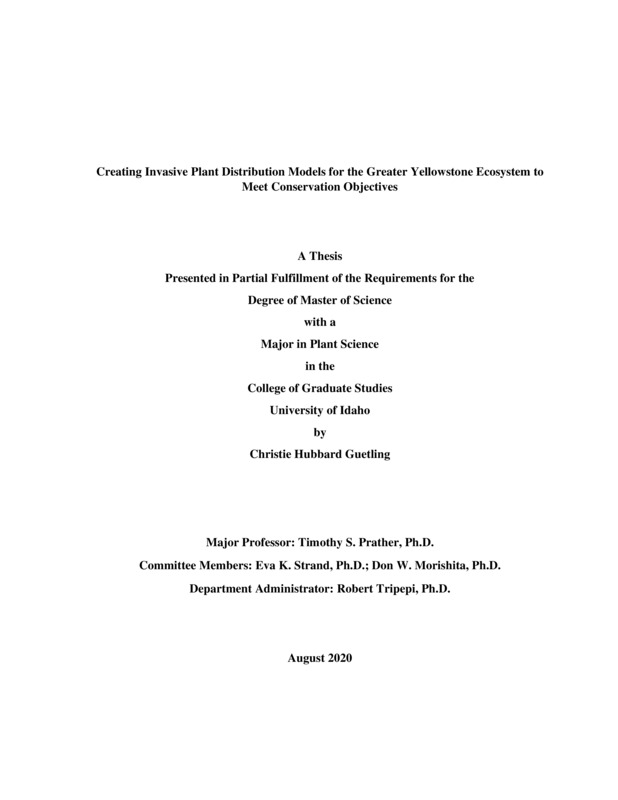Creating invasive plant distribution models for the Greater Yellowstone Ecosystem to meet conservation objectives
Guetling, Christie H. (2020-08). Creating invasive plant distribution models for the Greater Yellowstone Ecosystem to meet conservation objectives. Theses and Dissertations Collection, University of Idaho Library Digital Collections. https://www.lib.uidaho.edu/digital/etd/items/guetling_idaho_0089n_11875.html
- Title:
- Creating invasive plant distribution models for the Greater Yellowstone Ecosystem to meet conservation objectives
- Author:
- Guetling, Christie H
- Date:
- 2020-08
- Keywords:
- leafy spurge (Euphorbia esula) meadow hawkweed (Hieracium caespitosum) orange hawkweed (Hieracium aurantiacum) rush skeletonweed (Chondrilla juncea)
- Program:
- Plant, Soil and Entomological Sciences
- Subject Category:
- Plant sciences; Natural resource management; Conservation biology
- Abstract:
-
The Greater Yellowstone Ecosystem (GYE) is a unique and intact ecosystem that covers over 8-million hectares across portions of Idaho, Wyoming, and Montana. The GYE has been protected through active management for conservation of lands, waters, and wildlife by the Greater Yellowstone Coalition (GYC) since 1983. The conservation goals of the GYC are currently challenged by invasive plants that reduce forage quality and plant diversity. Susceptibility models within geographic information systems (GIS) can effectively direct ground surveys to locate invasive plant populations when their special extent is small. Early detection of infestations less than one hectare are commonly eradicated. Once an infestation reaches 1,000 hectares it is unlikely to be eradicated, so ongoing containment costs will be necessary. Every dollar spent on prevention can avoid 17 dollars spent on later control which is why early detection is critical. The first chapter of this thesis details construction of new susceptibility models for meadow hawkweed (Hieracium caespitosum) and orange hawkweed (Hieracium aurantiacum) in 1.31 ha of the GYE using known locations of each species with aspect, slope, precipitation, and Sentinel-2 satellite spectral data. Models were used to select transect locations within susceptible areas for plant cover acquisition to identify indicator species and habitat types. Approximately 662,000 ha were determined to be susceptible to meadow hawkweed and 436,000 ha were determined to be susceptible to orange hawkweed, representing 51% and 33% of the study area, respectively. Forty-three 20-meter transects were surveyed; seven indicator species of meadow hawkweed and three indicator species of orange hawkweed (two of which were indicators of both) were identified. Transects were in 10 different habitat types within predicted orange or meadow hawkweed susceptibility. Eight habitat types were shared by both species but only meadow hawkweed was predicted in the big sagebrush/Idaho fescue type and only orange hawkweed was predicted in the Douglas fir/common snowberry habitat type. The second chapter of this study extended susceptibility models created in Idaho, using Idaho presence data for leafy spurge (Euphorbia esula) and rush skeletonweed (Chondrilla juncea) into 1.12 million ha of the GYE. Model extension was used due to few known occurrences of leafy spurge or rush skeletonweed in the GYE that prevent creation of independent GYE models. The environmental variables used for these models were maximum temperature, minimum temperature, sun angle, precipitation, and National Agriculture Imagery Program spectral data. Susceptibility was divided into low, moderate, and high categories (plus a not-susceptible category). Only 105,100 ha (9% of the study area) were predicted to be susceptible to leafy spurge. Rush skeletonweed susceptibility was predicted across 396,500 ha (33% of the study area). Overall, the study area was at a low risk to leafy spurge and rush skeletonweed invasions based on the extension of Idaho susceptibility models. When managing a region as large as the GYE, it is important to prioritize efforts on landscapes at the greatest risk to invasion because funds are often limited, and early detection is critical for successful eradication or control.
- Description:
- masters, M.S., Plant, Soil and Entomological Sciences -- University of Idaho - College of Graduate Studies, 2020-08
- Major Professor:
- Prather, Timothy S
- Committee:
- Strand, Eva K; Morishita, Don
- Defense Date:
- 2020-08
- Identifier:
- Guetling_idaho_0089N_11875
- Type:
- Text
- Format Original:
- Format:
- application/pdf
- Rights:
- In Copyright - Educational Use Permitted. For more information, please contact University of Idaho Library Special Collections and Archives Department at libspec@uidaho.edu.
- Standardized Rights:
- http://rightsstatements.org/vocab/InC-EDU/1.0/

